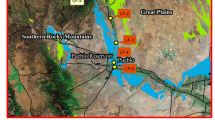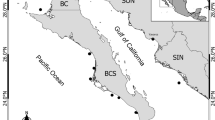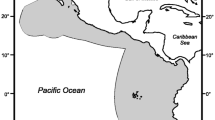Abstract
Total mercury (THg) and selenium (Se) concentrations were determined in hepatic, renal, and muscle tissues of seven specimens of Commerson’s dolphins incidentally captured in artisanal fisheries of Tierra del Fuego, Argentina, by instrumental neutron activation analysis. Liver yielded the mean highest concentration of THg 9.40 (9.92) μg g−1 dry weight (DW) (standard deviation of the average in parenthesis); kidney and muscle showed similar values, ranging from 2.34 to 3.63 μg g−1 DW. Selenium concentrations were similar in hepatic and renal tissues, with values from 13.62 to 14.56 μg g−1 DW; the lowest concentration was observed in muscle, 4.13 (2.05) μg g−1 DW. Among the specimens analyzed, the maximum concentrations of THg and Se were observed in the single adult female studied. An increasing age trend is observed for THg concentrations in tissues analyzed. The molar ratio of Se/Hg in the hepatic, renal, and muscle tissues were 8.7 (9.6), 13.2 (9.5), and 9.0 (11.4), respectively, suggesting Se protection against Hg toxicity. Silver concentrations in the three tissues were included, and the Se/(Hg + 0.5×Ag) molar ratio showed values closer to 1. Both Hg and Se concentrations in liver and kidney were comparable to those found in other small odontocetes from Argentine and Brazilian waters. This study constitutes the first joint description reported of Hg and Se concentrations in liver, kidney, and muscle of the Commerson’s dolphin species.



Similar content being viewed by others
References
Cuvin-Aralar MLA, Furness RW (1991) Mercury and selenium interaction: a review. Ecotoxicol Environ Saf 21:348–364
Ullrich S, Tanton T, Abdrashitova SA (2001) Mercury in the aquatic environment: a review of factors affecting methylation. Crit Rev Environ Sci Technol 31:241–293
Peterson SA, Ralston NVC, Whanger PD, Oldfield JE, Mosher WD (2009) Selenium and mercury interactions with emphasis on fish tissue. Environ Bioindicators 4:318–334
Khan MAK, Wang F (2009) Mercury-selenium compounds and their toxicological significance: toward a molecular understanding of the mercury-selenium antagonism. Environ Toxicol Chem 28:1567–1577
Sørmo EG, Ciesielski TM, Øverjordet IB, Lierhagen S, Eggen GS, Berg T, Jenssen BM (2011) Selenium moderates mercury toxicity in free-ranging freshwater fish. Environ Sci Technol. doi:10.1021/es200478b
Augier H, Park WK, Ronneau C (1993) Mercury contamination of the striped dolphin Stenella coeruleoalba Meyen from the French Mediterranean coasts. Mar Pollut Bull 26:306–311
Caurant F, Amiard JC, Amiard-Triquet C, Sauriau PG (1994) Ecological and biological factors controlling the concentrations of trace elements (As, Cd, Cu, Hg, Se, Zn) in delphinids Globicephala melas from the North Atlantic Ocean. Mar Ecol Prog Ser 103:207–219
Palmisano F, Cardellicchio N, Zambonin PG (1995) Speciation of mercury in dolphin liver: a two-stage mechanism for the demethylation, accumulation process and role of selenium. Mar Environ Res 40:109–121
Bowles D (1999) An overview of the concentrations and effects of metals in cetacean species. J Cetacean Res Manage Special Issue 1:125–148
Cardellicchio N, Decataldo A, Di Leo A, Misino A (2002) Accumulation and tissue distribution of mercury and selenium in striped dolphins (Stenella coeruleoalba) from the Mediterranean Sea (southern Italy). Environ Pollut 116:265–271
Heppleston PB, French MC (1993) Mercury and other metals in British seals. Nature 243:302–304
Honda K, Tatsukawa R, Itano K, Miyazaki N, Fujiyama T (1983) Heavy metal concentrations in muscle, liver and kidney tissue of striped dolphin, Stenella coeruleoalba, and their variations with body length, weight, age and sex. Agric Biol Chem 47:1219–1228
Bjerregaard P, Fjordside S, Hansen MG, Petrova MB (2011) Dietary selenium reduces retention of methylmercury in freshwater fish. Environ Sci Technol 45:9793–9798. doi:10.1021/es202565g
Caurant F, Navarro M, Amiard JC (1996) Mercury in pilot whales: possible limits to the detoxification process. Sci Total Environ 186:95–104
Koeman JH, Peeters WHM, Koudstaal-Hoi CHM, Tjioe PS, DeGoeij JJM (1973) Mercury-selenium correlations in marine mammals. Nature 245:385–386
Koeman JH, Van de Ven WSM, De Goeu JJM, Tjioe PS, van Haaften JL (1975) Mercury and selenium in marine mammals and birds. Sci Total Environ 3:279–287
Itano K, Kawai S, Miyazaki N, Tatsukawa R, Fujiyama T (1984) Mercury and selenium levels in striped dolphins caught off the Pacific coast of Japan. Agric Biol Chem 48:1109–1116
Leonzio C, Focardi S, Fossi C (1992) Heavy metals and selenium in stranded dolphins of the northern Tyrrhenian (NW Mediterranean). Sci Total Environ 119:77–84
Wagemann R, Trebacz E, Boila G, Lockhart WL (1998) Methylmercury and total mercury in tissues of arctic marine mammals. Sci Total Environ 218:19–31
Yang J, Kunito T, Tanabe S, Miyazaki N (2007) Mercury and its relation with selenium in the liver of Dall’s porpoises (Phocoenoides dalli) off the Sanriku coast of Japan. Environ Pollut 148:669–673
Martoja R, Berry J-P (1980) Identification of tiemannite as a probable product of demethylation of mercury by selenium in cetaceans. A complement to the scheme of the biological cycle of mercury. Vie Milieu 30:7–10
Nigro M, Leonzio C (1996) Intracellular storage of mercury and selenium in different marine vertebrates. Mar Ecol Prog Ser 135:137–143
Wagemann R, Trebacz E, Boila G, Lockhart WL (2000) Mercury species in the liver of ringed seals. Sci Total Environ 261:21–32
Ikemoto T, Kunito T, Tanaka H, Baba N, Miyazaki N, Tanabe S (2004) Detoxification mechanism of heavy metals in marine mammals and seabirds: interaction of selenium with mercury, silver, copper, zinc, and cadmium in liver. Arch Environ Contam Tox 47:402––413
Andre J, Boudou A, Ribeyre F, Bernhard M (1991) Comparative study of mercury accumulation in dolphins (Stenella coeruleoalba) from French Atlantic and Mediterranean coasts. Sci Total Environ 104:191–209
Frodello JP, Roméo M, Viale D (2000) Distribution of mercury in the organs and tissues of five toothed-whale species of the Mediterranean. Environ Pollut 108:447–452
Das K, Debacker V, Pillet S, Bouquegneau J (2003) Heavy metals in marine mammals. In: Vos JG, Bossart GD, Fournier M, O’Shea TJ (eds) Toxicology of marine mammals. Taylor and Francis, London, pp 135–167
Marcovecchio JE, Moreno VJ, Bastida RO, Gerpe MS, Rodríguez DH (1990) Tissue distribution of heavy metals in small cetaceans from the Southwestern Ocean. Mar Pollut Bull 21:299–304
Gerpe MS, Rodríguez DH, Moreno VJ, Bastida RO, de Moreno JAE (2002) Accumulation of heavy metals in the franciscana (Pontoporia blainvillei) from Buenos Aires Province, Argentina. Lat Am J Aq Mamm 1:95–106
Lailson-Brito J Jr, Azevedo MAA, Malm O, Ramos RA, Di Beneditto APM, Saldanha MFC (2002) Trace meals in liver and kidney of the Franciscana (Pontoporia blainvillei) from the northern coast of Rio de Janeiro State, Brazil. Lat Am J Aq Mamm 1:107–114
Monteiro-Neto C, Itavo RV, De Souza-Moraes LE (2003) Concentrations of heavy metals in Sotalia fluviatilis (Cetacea: Delphinidae) off the coast of Ceará, northeast Brazil. Environ Pollut 123:319–324
Kunito T, Nakamura S, Ikemoto T, Anan Y, Kubota R, Tanabe S, Rosas F, Fillmann G, Readman JW (2004) Concentration and subcellular distribution of trace elements in liver of small cetaceans incidentally caught along the Brazilian coast. Mar Pollut Bull 49:574–587
Seixas TG, Kehrig H, Fillman G, Di Beneditto AP, Souza CM, Secchi E, Moreira I, Malm O (2007) Ecological and biological determinants of trace elements accumulation in liver and kidney of Pontoporia blainvillei. Sci Total Environ 385:208–220
Seixas TG, Kehrig H, Costa M, Fillmann G, Di Beneditto APM, Secchi ER, Souza CM, Malm O, Moreira I (2008) Total mercury, organic mercury and selenium in liver and kidney of a South American coastal dolphin. Environ Pollut 154:98–106
Seixas TG, Kehrig HA, Di Beneditto APM, Souza CMM, Malm O, Moreira I (2009) Essential (Se, Cu) and non-essential (Ag, Hg, Cd) elements: what are their relationships in liver of Sotalia guianensis (Cetacea, Delphinidae)? Mar Pollut Bull 58:601–634
Carvalho CEV, Di Beneditto APM, Souza CMG, Ramos RMA, Resende CE (2008) Heavy metal distribution in two cetacean species from Rio de Janeiro State, south-eastern Brazil. J Mar Biol Assoc UK 88:1117–1120
Kehrig HA, Seixas TG, Palermo EA, Di Beneditto APM, Souza CMM, Malm O (2008) Different species of mercury in the livers of tropical dolphins. Anal Letters 41:1691–1699
Lailson-Brito J, Cruz R, Dorneles PR et al (2012) Mercury–selenium relationships in liver of Guiana dolphin: the possible role of Kupffer cells in the detoxification process by tiemannite formation. PLoS One. doi:10.1371/journal.pone.0042162
Honda K, Yamamoto Y, Kato H, Tatsukawa R (1987) Heavy metal accumulations and their recent changes in southern minke whales, Balaenoptera acutorostrata. Arch Environ Contam Toxicol 16:209–216
Kunito T, Watanabe I, Yasunaga G, Fujise Y, Tanabe S (2002) Using trace elements in skin to discriminate the populations of minke whales in southern hemisphere. Mar Environ Res 53:175–197
Goodall RNP, Galeazzi AR, Leatherwood S, Miller KW, Cameron IS, Kastelein RK, Sobral AP (1988) Studies of Commerson’s dolphins Cephalorhynchus commersonii, off Tierra del Fuego, 1976–1984, with a review of information on the species in the South Atlantic. Rep int Whal Comm Special Issue 9:3–70
Goodall RNP, Schiavini A, Fermani C (1994) Net fisheries and net mortality of small cetaceans off Tierra del Fuego, Argentina. Rep int Whal Comm Special Issue 15:295–304
Riccialdelli L, Newsome SD, Fogel ML, Goodall RNP (2010) Isotopic assessment of prey and habitat preferences of a cetacean community in the southwestern South Atlantic Ocean. Mar Ecol Prog Ser 418:235–248
Bastida R, Lichtschein V, Goodall RNP (1988) Food habits of Cephalorhynchus commersonii off Tierra del Fuego. Rep int Whal Comm Special Issue 9:143–160
Norris KS (1961) Standardized methods for measuring and recording data on the smaller cetacea. J Mammal 42:471–476
Perrin WF, Myrick AC (1980) Age determination of toothed whales and Sirenians. Rep int Whal Commn Special Issue 3:1–50
Dellabianca NA, Hohn AA, Goodall RNP (2012) Age estimation and growth layer patterns in teeth of Commerson’s dolphins (Cephalorhynchus c. commersonii) in subantarctic waters. Mar Mamm Sci 28:378–388
Rizzo A, Arcagni M, Arribére MA, Bubach D, Ribeiro Guevara S (2011) Mercury in the biotic compartments of Northwest Patagonia lakes, Argentina. Chemosphere 84:70–79
Lockyer C, Smellie CG, Goodall RNP, Cameron IS (1981) Examination of teeth of Commerson’s dolphins Cephalorhynchus commersonii for age determination. J Zool Soc Lond 195:123–131
Lockyer C, Goodall RNP, Galeazzi AR (1988) Age and body length characteristics of Cephalorhynchus commersonii from incidentally-caught specimens off Tierra del Fuego. Rep int Whal Comm Special Issue 9:103–118
Gaskin DE (1982) The ecology of whales and dolphins. Heinemann Educational, Oxford
Haraguchi H (1999) Multielement profiling analyses of biological, geochemical, and environmental samples as studied by analytical atomic spectrometry. Bull Chem Soc Jpn 72:1163–1186
Ikemoto T, Kunito T, Watanabe I, Yasunaga G, Baba N, Miyazaki N, Petrov EA, Tanabe S (2004) Comparison of trace element accumulation in Baikal seals (Pusa sibirica), Caspian seals (Pusa caspica) and northern fur seals (Callorhinus ursinus). Environ Pollut 127:83–97
Dehn L-A, Follmann EH, Rosa C, Duffy LK, Thomas DL, Bratton GR, Taylor RJ, O’Hara TM (2006) Stable isotope and trace element status of subsistence-hunted bowhead and beluga whales in Alaska and gray whales in Chukotka. Mar Pollut Bull 52:301–319
Olsson U (1985) Impaired ketone body metabolism in the selenium deficient rat. Possible implications. Metabolism 34:933–938
Hansen CT, Nielsen CO, Dietz R, Hansen MM (1990) Zinc, cadmium, mercury and selenium in minke whales, belugas and narwhals from West Greenland. Polar Biol 10:529–539
Roditi-Elasar M, Kerem D, Hornung H, Kress N, Shoham-Frider E, Goffman O, Spanier E (2003) Heavy metal levels in bottlenose and striped dolphins off the Mediterranean coast of Israel. Mar Pollut Bull 46:491–521
Becker PR, Mackey EA, Demiralp R, Suydam R, Early G, Koster BJ, Wise SA (1995) Relationship of silver with selenium and mercury in the liver of two species of toothed whales (odontocetes). Mar Pollut Bull 30:262–271
Agusa T, Nomura K, Kunito T, Anan Y, Iwata H, Miyazaki N, Tatsukawa R, Tanabe S (2008) Interelement relationships and age-related variation of trace element concentrations in liver of striped dolphins (Stenella coeruleoalba) from Japanese coastal waters. Mar Pollut Bull 57:807–815
Holsbeek L, Siebert U, Joiris CR (1998) Heavy metals in dolphins stranded on the French Atlantic coast. Sci Total Environ 217:241–249
O’Shea TJ (1999) Environmental contaminants and marine mammals. In: Reynolds JE, Rommel SA (eds) Biology of marine mammals. Smithsonian Institution Press, Washington, pp 485–563
Aguilar A, Borrell A, Pastor T (1999) Biological factors affecting variability of persistent pollutants levels in cetaceans. J Cet Res Manag 1:83–116
Raymond LJ, Ralston NVC (2009) Selenium’s importance in regulatory issues regarding mercury. Fuel Proc Tech 90:1333–1338
Dumont E, Vanhaecke F, Cornelis R (2006) Selenium speciation from food source to metabolites: a critical review. Anal Bio Chem 385:1304–1323
Belzile N, Chen Y-W, Yang D-Y, Thi Truong H-Y, Zhao Q-X (2009) Selenium bioaccumulation in freshwater organisms and antagonistic effect against mercury assimilation. Environ Bioindicators 4:203–221
Wagemann R, Muir DCG (1984) Concentrations of heavy metals and organochlorines in marine mammals of northern waters: overview and evaluation. Can Tech Rep Fish Aquat Sci 1279:1-97
Krone CA, Robisch PA, Tilbury KL, Stein JE, Mackey A, Becker P, O’Hara TM, Philo LM (1999) Elements in tissues of bowhead whales (Balaena mysticetus). Mar Mamm Sci 15:123–142
Woshner VM, O’Hara TM, Bratton GR, Beasley VR (2001) Concentrations and interactions of selected essential and non-essential elements in ringed seals and Polar bears of Arctic Alaska. J Wild Dis 37:711–721
Cáceres-Saez I, Ribeiro Guevara S, Dellabianca NA, Goodall RNP, Cappozzo HL (2012) Heavy metals and essential elements in Commerson’s dolphins (Cephalorhynchus c. commersonii) from the southwestern South Atlantic Ocean. Environ Monit Assess. doi:10.1007/s10661-012-2952-y
Beck KM, Fair P, McFee W, Wolf D (1997) Heavy metals in livers of bottlenose dolphins stranded along the South Carolina coast. Mar Pollut Bull 34:734–739
Sasakura C, Suzuki KT (1998) Biological interaction between transition metals (Ag, Cd and Hg), selenide/sulfide and selenoprotein P. J Inorg Biochem 71:159–62
Gil MN, Torres A, Harvey M, Esteves JL (2006) Metales pesados en organismos marinos de la zona costera de la Patagonia Argentina continental. Rev Biol Mar Oceanog 41:167–176
Seixas TG, Kehrig HA, Di Beneditto APM, Souza CMM, Malm O, Moreira I (2009) Trace elements in different species of cetacean from Rio de Janeiro coast. J Braz Chem Soc 20:243–251
Moura JF, Souza Hacon S, Vega CM, Hauser-Davis RA, de Campos RC, Siciliano S (2011) Guiana dolphins (Sotalia guianensis, Van Benédén 1864) as indicators of the bioaccumulation of total mercury along the Coast of Rio de Janeiro State, Southeastern Brazil. Bull Environ Contam Toxicol 88:54–59
Bisi TL, Lepoint G, Azevedo AF, Dorneles PR, Flach L, Das K, Malm O, Lailson-Brito J (2012) Trophic relationships and mercury biomagnification in Brazilian tropical coastal food webs. Ecol Indicators 18:291–302
de Moreno JEA, Gerpe MS, Moreno VJ, Vodopivez C (1997) Heavy metals in Antarctic organisms. Polar Biol 17:131–140
Acknowledgments
We are grateful to A. Rizzo and M. Arcagni for their support in sample conditioning and to the reactor RA-6 operation staff for their technical assistance in sample irradiation. ICS would like to express her appreciation to D. Janiger for the useful and valuable literature support, M.S. Saez Falcucci for giving her continuous and generous assistance during this work, M.O. Cáceres and F. Pereyra Bonnet for their constructive comments on the manuscript. RNPG is grateful to the Committee for Research and Exploration of the National Geographic Society and Total Austral SA for their continuing support to the field work carried out in Tierra del Fuego and the Museo Acatushún de Aves y Mamíferos Marinos Australes’ AMMA project. We appreciate the hard work of AMMA volunteers who helped with the collection and the dissection of the specimens, and our sincere gratitude goes to the collaboration of the artisanal fishermen. ICS was supported by a PhD fellowship from the Consejo Nacional de Investigaciones Científicas y Técnicas (CONICET) of Argentina and was funded by Grants in Aid of Research from the Cetacean Society International (CSI) and the Society for Marine Mammalogy (SMM). Research in Tierra del Fuego is carried out under permit from the local government. All samples were transferred under licences extended by the Secretaría de Ciencia y Tecnología, Secretaria de Desarrollo Sustentable y Ambiente, and SENASA, Tierra del Fuego, Argentina. We would like to thank two anonymous referees for their reviews.
Author information
Authors and Affiliations
Corresponding author
Rights and permissions
About this article
Cite this article
Cáceres-Saez, I., Dellabianca, N.A., Goodall, R.N.P. et al. Mercury and Selenium in Subantarctic Commerson’s Dolphins (Cephalorhynchus c. commersonii). Biol Trace Elem Res 151, 195–208 (2013). https://doi.org/10.1007/s12011-012-9555-x
Received:
Accepted:
Published:
Issue Date:
DOI: https://doi.org/10.1007/s12011-012-9555-x




